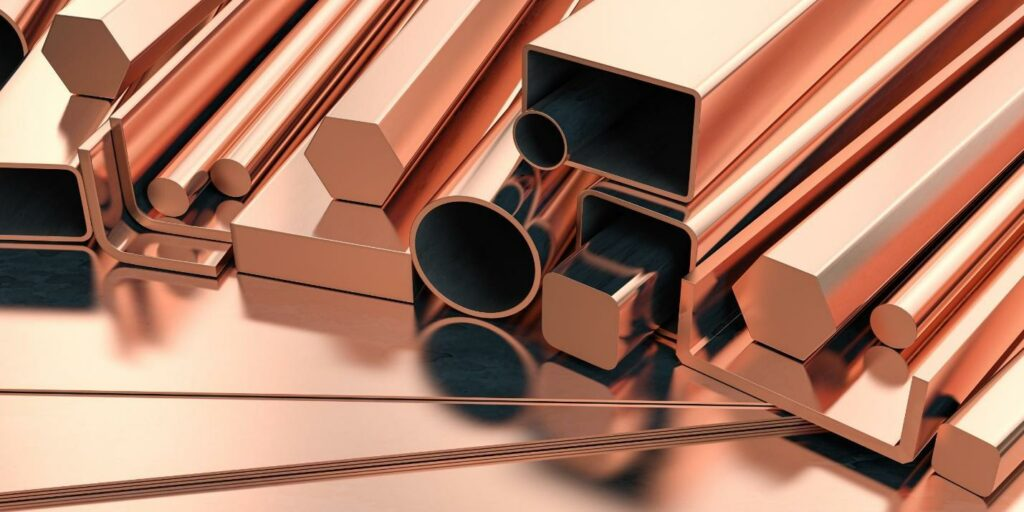Copper is one of the oldest and most versatile metals known to humanity. Its distinctive appearance has made it a popular choice for different applications, ranging from electrical wiring to architectural features. However, many people are puzzled by its color: is copper pink or brown? The answer isn’t as straightforward as it seems because copper can appear in various shades depending on its form, oxidation state, and environmental exposure.
This article will explore copper’s unique characteristics, its typical color range, and how external factors can alter its hue. We will also discuss how you can intentionally change the color of copper parts to achieve the desired aesthetic or functional effects.
Brief Overview of Copper
Copper is a chemical element known for its excellent electrical and thermal conductivity. Humans have used it for thousands of years, and it is essential in various industries, including electrical engineering, plumbing, and construction. Copper’s malleability and resistance to corrosion make it highly valued in manufacturing. Likewise, its ability to conduct electricity with minimal energy loss makes it indispensable in electrical applications.
Raw copper alloy
Features
Copper boasts several unique features that make it stand out among metals:
- High Electrical Conductivity: Copper is among the top metals in terms of electrical conductivity. Thus, it is ideal for wiring, electrical components, and electronic devices.
- Thermal Conductivity: It efficiently conducts heat, which is why it is often used in heat exchangers, cooking utensils, and heating systems.
- Corrosion Resistance: Despite being a reactive metal, copper forms a protective layer when it oxidizes, preventing further degradation. This characteristic is particularly important in plumbing and outdoor installations.
- Malleability and Ductility: Copper is easy to shape and bend without breaking, making it a popular choice for intricate designs and detailed metalwork.
- Antimicrobial Properties: This metal has natural antimicrobial properties, which is why it’s often used in medical environments or in materials that need to prevent bacterial growth.
- Aesthetic Appeal: Copper’s distinctive reddish hue and its ability to develop a patina over time give it aesthetic value in decorative arts and architecture.
Pros
There’s a wide range of advantages that have contributed to copper’s longevity and widespread use:
- Excellent Electrical and Thermal Conductor: It is commonly used in electronics applications due to its ability to efficiently conduct electricity and heat.
- Durability: This metal is a durable option that can last for centuries, especially when treated properly. Its corrosion resistance enhances its longevity in outdoor environments.
- Recyclable: Copper can be recycled without losing its valuable properties, making it an environmentally sustainable material.
- Versatility: Copper’s aesthetic qualities allow it to be used in various industries, including construction, transportation, electrical, and even artwork.
- Antimicrobial Properties: This feature makes copper ideal for where hygiene is critical, such as in hospitals and food preparation areas.
Cons
Despite its advantages, copper has a few drawbacks:
- Cost: Copper is relatively expensive compared to other metals like aluminum, which can be a downside in budget-conscious projects.
- Oxidation: While the protective oxide layer is beneficial for corrosion resistance, it can alter the appearance of copper over time, changing its color and potentially leading to a green patina.
- Weight: Copper is heavier than some other materials like aluminum, which may be a disadvantage in applications requiring lightweight components.
- Softness: Copper’s malleability can also be a downside in some situations. It is relatively soft and may deform under heavy loads or stress compared to harder metals like steel.
Is Copper Pink or Brown?
Copper can be pink or brown, depending on its state. Copper has a reddish-pink hue when freshly polished or in a pure, unoxidized form. However, as it reacts with air and oxidizes, its color gradually shifts to brown. Over time, further exposure to environmental elements like moisture or pollution may lead to the development of a greenish patina. Let’s go into further details.
Machined copper parts
Freshly Polished Copper
When copper is freshly polished, it has a striking reddish-pink or salmon-like color. This hue results from copper’s specific interaction with light, where it reflects red and orange wavelengths more than others. When copper is polished, the smooth surface amplifies this reflection, giving it a bright, lustrous finish. The reddish-pink color is one of copper’s most defining characteristics and is often seen in newly minted coins or freshly manufactured copper components.
Metal fabricators value this reddish-pink appearance for decorative purposes. For example, architectural elements like copper roofs, domes, or wall cladding are often installed with the intention of showcasing copper’s initial shine. Similarly, copper cookware is prized for its aesthetic appeal in addition to its excellent heat conductivity. In electrical wiring, the copper is typically polished during production but not necessarily for aesthetic reasons—its conductive properties remain the priority.
Oxidized Copper
As copper is exposed to air, it begins to react with oxygen. This leads to the formation of copper oxide. When oxidation first begins, the copper surface darkens, taking on a light brown hue. As the oxidation process continues, the brown deepens, and the copper may develop patches of darker areas or even black spots. The speed of oxidation depends on the environment—higher humidity or pollution can accelerate the process. The brown shade may range from light to dark brown, depending on the level of oxidation.
Oxidized copper is embraced in many applications. In architecture, for example, the natural aging process of copper is often considered a desirable aesthetic feature. Copper roofs and other structural elements are allowed to oxidize naturally, giving them a rich, earthy brown tone that complements many building styles. Even in electrical applications, the oxidation layer does not significantly affect copper’s ability to conduct electricity, making it a durable choice for wiring.
Patinated Copper
Patination is essentially a more advanced stage of oxidation. Copper initially reacts with oxygen to form brown copper oxide. However, prolonged exposure to elements such as water, carbon dioxide, sulfur dioxide, and chlorides leads to the formation of copper carbonate and other compounds that give the metal its characteristic green hue. This patina, commonly seen in old copper roofs or statues, typically appears as a bluish-green coating. While the underlying metal remains copper, the patina alters its appearance dramatically. This transformation is a natural protective mechanism that prevents further corrosion.
Patinated copper is widely used in the manufacturing industry for its aesthetic appeal and functional benefits. Its corrosion resistance makes it valuable in marine applications such as ships and offshore structures. Industrial applications, including piping in chemical plants and water treatment facilities, benefit from patinated copper’s ability to withstand harsh environments. Its use also extends to luxury consumer goods, like high-end cookware, sinks, and bathtubs. The patina adds an elegant, aged appearance over time while maintaining excellent functionality.
How to Change the Color of Copper Parts
If you want to alter the color of copper parts for aesthetic or functional reasons, you can use any of these methods to achieve the desired result.
Copper parts with different colors
Polishing
If your copper part has developed oxidation or patina, polishing it can restore its original pinkish-red shine. Using polishing compounds, sandpaper, or even a simple mixture of lemon juice and salt can help remove the oxidation layer and reveal the fresh copper beneath. However, keep in mind that this is a temporary solution, and the copper will begin to oxidize again unless sealed.
Applying Heat (Flame Coloring)
Heat can dramatically change the color of copper. By applying a torch or flame to copper, you can induce a variety of colors, ranging from deep reds to purples and blues. This process, called flame coloring, causes the metal to react with the air and heat, creating a thin oxide layer that reflects different colors based on the temperature and duration of heating.
Chemical Treatments
Certain chemicals can speed up the patination process or give copper a desired color. For example, ammonia vapors can turn copper blue, while vinegar can give it a green patina. Artists or builders use these methods to give copper parts a vintage or antique look without waiting for natural oxidation to take place.
Plating
opper parts can also be coated or plated with other metals to change their color. Gold, silver, or nickel plating is commonly used to alter the appearance of copper while maintaining its underlying properties. This process is widely used in jewelry making, electronics, and decorative items.
Coatings and Finishes
Clear or tinted lacquer coatings can protect copper from oxidation and give it a glossy or matte finish, depending on your preference. You can also apply tinted coatings to change the appearance of the copper without altering the metal itself. This method is useful for preserving the original color of copper while preventing further color change over time.
Conclusion
Copper’s distinctive appearance can range from a bright pinkish-red to a deep brown or even a greenish hue, depending on its environmental exposure and treatment. Freshly polished copper tends to have a warm, pinkish tone. Meanwhile, oxidation gradually turns it brown over time, and prolonged exposure can lead to a beautiful patina.
The versatility of copper in both its physical and visual properties makes it a favored material across industries, from construction to electronics. Whether you’re maintaining copper’s original shine or deliberately changing its color for aesthetic purposes, understanding how copper’s appearance evolves over time will help you make the most out of this unique metal.

